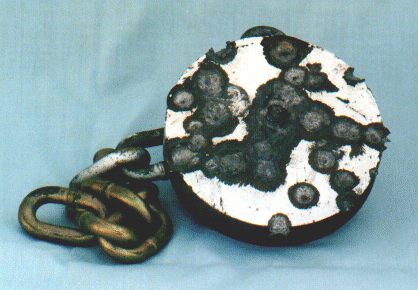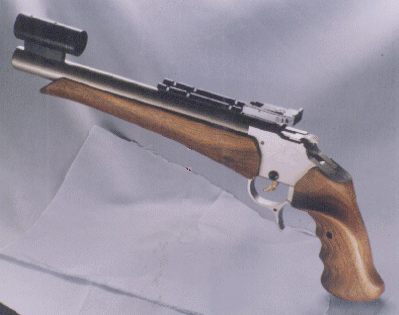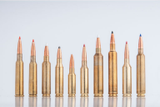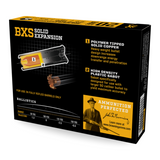BRM - Bench Rest Magnum Cartridges
BRM Cartridges - General Information and Descriptions
The BRM series of cartridges were developed to give big game hunting performance in cartridges that are optimized for small framed rifles and single shot handguns... Such as our Model 97D Rifle, BF Pistol, TC Contender/G2, and TC Encore. The first (and most successful) cartridge in this series is the 6.5mm BRM. Essentially it is a lengthened and necked up version of the Bench Rest 219 Donaldson Wasp with about 10 gr more powder capacity... a Bench Rest "Magnum" case and thus the name "BRM". After the 6.5mm BRM, we developed the same case in different calibers. There's a fairly extensive article on the development of the 6.5mm BRM if you scroll further on down the page from here.
6.5mm BRM
- Optimized for the heavy 140 gr bullets and 1:8 rifling twist, this
cartridge has seen phenomenal success hunting big game all over the
world. Most popular for deer and antelope hunting in our Model 97D
Rifle. The 140 gr 6.5mm bullet compares to a 190 gr 30 caliber bullet
in deadly impact... But with far less recoil.
6mm BRM -
Optimized for 100 grain .243 caliber bullets with a 1:8 rifling twist,
this cartridge gives velocities approxi-mately the same as .243
Winchester on bullet weights of 90 grains and less... Excellent
Antelope cartridge. Load lighter bullets, and it doubles as a
terrific varmint cartridge, too.
7mm BRM -
Optimized for the heavy 160-162 gr bullets and 1:9 rifling twist, this
cartridge performs almost as well as the 6.5mm BRM but has not enjoyed
the same success. The 162 gr 7mm bullet offers the same huge sectional
density as the 140 gr. 6.5mm but the 6.5mm BRM recoils a little less
and has a phenomenal kill reputation.
300 BRM
- Originally intended to follow the "High Sectional Density" heavy
bullet formula of the 6.5mm BRM, this one is a little shy on case
capacity for the intended 180-190 gr. bullets. Instead, it has found a
new following with the lighter, 165 gr. 30 caliber bullets. It is VERY
accurate with 165 gr. bullets. A side benefit of 300 BRM is that you
can fire standard 30-30 ammo with decent results if you run out of 300
BRM handloads.
224 BRM - Since the
smaller 219 Donaldson Wasp is considered near perfect in case capacity
for 40-55 gr bullets to shoot accurately, this longer 224 BRM has a
greater case capacity in order to shoot the heavier 70 grain bullets.
The chamber is throated for these longer bullets and we recommend the
1:8 rifling twist.
This cartridge will shoot lighter bullets plenty fast but remember it is
set up with a long throat and twist rate that is optimal for heavy
bullets.
6.5mm BRM Hunting Cartridges: The Medium Velocity Heavy Bullet Approach to Accuracy and Effectiveness
- What we Learned from the 6.5x55 Swedish Mauser
- Bullet Weight, Velocity, Sectional Density, and Ballistic Coefficient
- Trajectory and Wind Drift
- Momentum vs. Energy
- The Myth of Expansion
- Accuracy Facts from Bench Rest and Silhouette Competition
By combining the influences of bench rest cartridges, handgun metallic silhouette cartridges, the Swedish Mauser, "Shaped Charge" loading dynamics, modern developments in powder and bullet technology, and field experience, we've come up with a different approach to hunting cartridge design. We call it the 6.5mm BRM... A medium velocity, heavy bullet cartridge with bench rest accuracy that's deadly reliable on big game out to 300 yards... And boasting of relatively mild recoil, too!
264 Yards, One Heart Shot... 6.5mm BRM
I put the crosshairs a little high on the shoulder and
squeezed the trigger. The bullet broke the leg and made a
quarter-sized hole in the rib cage, passed through lung and
heart, and broke through the rib cage as it exited out the
other side. The antelope dropped right where it was hit.
6.5mm BRM delivers the accuracy and trajectory to
hit reliably at long range, and the deadly performance to
put game down in one shot.
EABCO 6.5mm BRM Cartridges
The same sectional density and velocity as the
Swedish Mauser with
Bench Rest Loading
efficiency. Recoil is mild. Accuracy is Superb.
One Shot Performance on Game is Deadly Out to
300 Yards.
Influences of the Swedish Mauser. With velocities less than a 30-06, the mild recoiling 6.5X55 Swedish Mauser has been used widely to take game from varmints to deer to reindeer, caribou, and moose. Some say it was even used to kill elephants in Africa! Americans who've hunted with the Swede experience drop-where-they-stand effectiveness on game. The "magic" of this cartridge has garnered an almost cult following among it's fans. Why it works so well has been attributed to the "Sectional Density" (SD) of the 6.5mm bullet, but that's only half of the formula. The fact is, there are 7mm and .30 caliber bullets with the same or very similar sectional density. Why don't they have the same magic reputation of the 6.5mm? Well, the only other factor in the mix is the medium velocity of the Swede. The original 6.5X55 Swedish Mauser load throws a 140 gr. bullet about 2300-2500 fps depending on barrel length. That's deceptively slower that most 7mm and 30 caliber cartridges... And most folks forget they're comparing apples to oranges (Its not correct to compare velocities of mixed calibers using the same bullet weights). Comparable Sectional Densities mean different bullet weights. As you can see from the chart below, 7mm and 30 caliber bullets that have similar characteristics to the 6.5mm are considerably heavier, recoil harder, and shoot about the same velocity.
| Cartridge | Weight |
Sectional Density
|
Ballistic Coefficient
|
Best Twist | Velocity |
|
6.5mm BRM
|
140 gr
|
.287 | .550 | 1:8 | 2450 |
|
7-08 Rem
|
162 gr
|
.287 | .534 | 1:9 | 2400 |
|
300 Win
|
190 gr
|
.286 | .530 | 1:10 | 2500 |
A 140gr bullet in the 6.5mm BRM is COMPARABLE to a heavy bullet load in 7mm and 30 Caliber! The 6.5mm BRM is a Mild Recoiling Sledge Hammer!

Bullet Weight, Velocity, Sectional Density. If a baby
squirrel falls out of a tree from 20 ft up, it doesn't get
injured. But if a man falls that far, he'll break bones. The
distance and speed (velocity) of the fall are the same but,
the man weighs more and this gives him a lot more momentum.
Now, take the man's weight and shape it into a long,
skinny rod falling end first (kind of like a bullet). The
end of that rod exerts the full bone crushing momentum of
the man into a much smaller "section" of ground... driving
it deep into the ground. The "Sectional Density" of the rod
is much more than that of the man, even though their weight
is the same. From the chart above, you can see that in
bullets:
The larger the impact area (caliber) the greater
the bullet weight needs to be to maintain the same sectional
density as the 6.5mm BRM.
The "Ballistic Coefficient" (BC) is a function of bullet
shape and weight. Long, heavy, pointed bullets have high BCs... They sail further and buck the wind better than
short, lightweight bullets with low BCs. Since the 6.5mm BRM cartridge uses bullets with high Ballistic
Coefficients, they are naturally superb at long range
performance.
Why Medium Velocity is More Effective. Here's a simple illustration: If you shoot an aluminum pop can with a 900 fps magnum pellet rifle, the soft lead (expanding) pellet will zip right through the metal without disturbing the can. Now, if you shoot the can with a slower 500 fps steel BB (non-expanding), it will also go through the can but, it will bend-in the aluminum on its way through, knock the can over and throw it back a foot or so. The slower velocity imparts more "hang time" of the bullet momentum on the target. Silhouette competitors are quite familiar with the concept of Hang Time... a bullet that holds its full weight and momentum on the steel silhouette target rather than losing it all to over-energized fragmentation or high speed penetration. The medium-velocity (2400-2500 fps) achieved by the Swedish Mauser (and EABCO 6.5mm BRM) works in the same way to produce more "Hang Time" as it passes through animal tissue.
What About Long Range Trajectory?
A common misconception is that ultra-high velocity translates into ultra-high velocity translates into enormous gains in long range shooting ability... but, it just isn't so. Look at the trajectories of the medium velocity 6.5mm BRM compared to loads of similar sectional density in 308 and 300 Win Mag below. For hunting big game with all three cartridges, you can aim right on all the way out to 200 yards and a predictable hold over will hit at 300 yards. Beyond 300 yards, skill, accuracy, shootability, and sight settings will have more influence than trajectory.
|
Caliber (Chambering)
|
Velocity |
100 yd
|
200 yd
|
300 yd
|
|
6.5mm/140 gr (6.5mm BRM)
|
2,400 fps
|
+2.8" | 0.0" | -10.7" |
|
30 cal/190 gr (308 Winchester)
|
2,500 fps
|
+3.0" | 0.0" | -9.7" |
|
30 cal/190 gr (300 Win Mag)
|
2,900 fps
|
+2.0" | 0.0" | -6.9" |
What About Wind Drift? Light bullets and high velocity don't hold any significant advantage over the medium velocity/heavy bullet approach when it comes to long range wind drift. But the trade-off for high velocity is over energized bullets that can either fragment and under perform (fail) on game or go completely the other way and destroy large sections of game meat. The chart below shows drift with a 10 mph wind on the 6.5mm BRM cartridge vs. a popular high velocity 30-06 loading.
CHART
|
Caliber (Chambering)
|
Velocity
|
100 yd Drift
|
200 yd Drift
|
300 yd Drift
|
|
6.5mm/140 gr (6.5mm BRM)
|
2,400 fps
|
.82" | 3.41" | 7.9" |
|
30 Cal/150 gr (30-06)
|
2,900 fps
|
.80" | 3.3" | 7.9" |
Momentum vs. Energy. Momentum is what drives a bullet through muscle, bone, sinew, and cartilage. Energy is what causes a bullet to expand or fragment. Energy is also what causes shock damage to living tissue. You can't really have too much momentum, but you CAN have too much energy... witness the explosive meat damage that occurs when a 30-06 passes through the shoulder of a deer.
One Object of the Medium Velocity, Heavy Bullet 6.5mm BRM Approach is to Maximize Momentum without over-energizing the bullet.
The Myth of "Reliable" Bullet Expansion. The purpose of
bullet expansion could be looked at as adding "hang-time" to
a bullet that is moving too fast (like the pop can example
above). But, bullets expand differently depending on what
they strike and how fast they're moving. A bullet that
expands well on soft tissue can fragment without penetration
when it hits something harder... like a bone. A bullet that
holds together on bone at high velocity will zip right
through soft tissue.
Is high velocity even needed?
Apparently Not: I've seen
7mm
rifle bullets expanded completely flat
after hitting 200
meter handgun silhouette targets and having had a muzzle
velocity of only 1,800 fps.
Into this you have to figure that the bullet loses
velocity the further it travels... it may expand well on
game at 100 yards but not 200 yards... or vice versa.
Non-Fragmenting Bullet Expansion is good if it
happens, but...the 6.5mm BRM approach is to go with
inherent "Hang Time" of medium velocity and Penetration you
can count on from a well built, high sectional density
bullet... It therefore works regardless of whether the
bullet expands or not.
LINE
Loading for Accuracy...
Influences of Bench Rest and Silhouette
Shaped Charges, Efficiency, and Bench Rest Accuracy.
The modern Bench Rest cartridge originated with the 219
Donaldson Wasp and the research conducted by Harvey
Donaldson. Donald-son's work was to find the most efficient
and consistent cartridge for shooting the lightweight .224
caliber bullets. To keep the powder ignition consistent, the
case needed to be full of powder. The full case needed to
contain an optimum amount of powder to ignite fully within
the barrel length, and the shape of the case needed to be
optimized to accomplish as complete a burn as possible from
shot to shot. Well, when you combine those features you get
a powder charge that is essentially the same shape and
density from one shot to the next... a "shaped" charge. And
a cartridge so efficient as to burn all of the powder within
the barrel presents no turbulent fireball to upset the
bullet as it exits the muzzle. The result is Accuracy.
Harvey Donaldson's "219 Donaldson Wasp" was the
ultimate case capacity and shape (30º Shoulder Angle) and
you see the same characteristics in modern "BR" designated
cartridges of many calibers.

Heavy Bullets and Bench Rest Cartridges. The original 219 Donaldson Wasp and later 22 BR cartridges fired lightweight bullets in rifle length barrels. When IHMSA (International Handgun Metallic Silhouette) began, they needed accurate cartridges that fired heavy bullets in short (handgun) barrels. As it turned out, the Bench Rest case capacity worked perfectly. First as the 7mm BR and then as the 7mm Ultimate Silhouette derivative of the original 219 Don Wasp. This little 7mmUS cartridge holds the world record set by Rich Mishler and his BF Ultimate Silhouette Pistol for 500 meter iron sight silhouettes... hitting and knocking over 9 out of 10 of the 60 lb. Ram targets at 500 meters!
Heavy Bullets and Case Capacity. The original
219 DW and 22 BR dimensional characteristics of case
capacity and shoulder angle were designed for lightweight
bullets in a rifle length gun barrel. Heavy bullets need
slightly more case capacity to be efficient in a rifle. For
our 6.5mm BRM cartridge, we were looking
for a case capacity that would give the "BR" shaped charge
loading density and powder burning efficiency while
launching a heavy bullet at a target velocity of 2,400 fps.
The 6.5mm BRM cartridge achieves this with a completely full
case of powder. Derived from the 219 Donaldson
Wasp and made from 30-30 Winchester brass, the 6.5mm BRM cartridge has the same shoulder dimensions and 30°
angle to burn the powder charge efficiently within the
length of the rifle barrel.
There's very little muzzle
turbulence, the same sectional density and velocity as the
Swedish Mauser, mild recoil, and the long range accuracy is
superb.
LINE
Modern Bullets and Gun Powders
P.O. Ackley, in his Handbook for Shooters and Reloaders, wrote about how the 22-250 came to be banned from big game hunting because of bullet failure... bullets that fragmented and didn't penetrate due to extreme velocity at impact. He went on to talk about hunting guides who's clients shooting 300 Winchester Magnum had similar problems: Bullets blowing a big surface wound without penetrating. He went on to write about some solid copper "Controlled Expansion" bullets he designed that solved a lot of these problems. The modern Barnes X-Bullet is a direct descendent of this bullet and an excellent design. However, being solid metal, it behaves differently as it is squeezed through the rifle barrel. I have had mixed success in achieving accuracy with the Barnes X, though I know others have had excellent results with it. It holds together on game.
Nosler has taken a different approach
with their "Partition" bullets. Encasing the rear portion of
the lead core keeps it intact and assures good penetration.
I've achieved excellent accuracy with the Nosler Partition
and taken several heads of big game with one-shot kills.
However, I had one occasion where the bullet did a lot of
entry damage and popped out the back side of the animal
making only a pencil sized hole. I concluded that the core
in the nose had separated and the bullet tumbled and popped
out backwards... I may be wrong on this conclusion. Until
then, I had absolute confidence in the Partition bullet.
Since then others have reported similar failures.
Jacket Separation... The Cause of Most Bullet
Failures:
Modern rifle bullets feature a lead core with a
swaged copper jacket. While the copper holds together fairly
well, it is thin and light. The core on the other hand is
heavy but soft... it breaks up easy. In typical bullet
failure, the jacket and core separate, fragment, and become
a bunch of much less heavy projectiles that don't penetrate.
Core Bonding... The Solution to Jacket Separation:
Molecular bonding of the lead core with the copper jacket
produces much better terminal performance in hunting
bullets. I'm not an expert on the process but essentially
the lead core is welded to the copper bullet jacket so it
can't peel away. It's an expensive process and "Bonded"
bullets aren't cheap. But instead of jacket separation and
fragmentation, Bonded bullets hold together, retain their
weight well, and penetrate deep.
Controlled Expansion WITH
Bonding:
By making the copper jacket taper from thin at the
tip to thick at the base, the expansion becomes stiffer as
it progresses. Combining this with a bonded core results in
the
Scirocco bullet from Swift
Bullet Company. It gives good expansion over a wide range of
velocities (1,440-2700+ fps) while it holds together and
delivers great penetration.
Encasing WITH Bonding: If you
take the Nosler partition approach and add core bonding, you
get the Swift bullet. The nose
section expands without separating or fragmenting and the
rear section holds its full weight together to drive the
bullet through whatever tissue and bone it encounters. An
extreme terminal performance bullet, the A-Frame has gained
a solid reputation killing dangerous game.
A.P.E... How Good Do Your Hunting Bullets Have to Be?
A fellow named Odell Register told me about his A.P.E. acronym. It's the priority and criteria for hunting bullets: Accuracy is the first requirement. Penetration is the second. Energy is last on the list... all the energy in the world is useless if you miss or don't penetrate. The point is: When your shot of a lifetime comes along, the first thing you have to do is be able to hit the vitals. That means your bullet has to be accurate. The second thing you have to do is penetrate through the vitals. This means your bullet has to be heavy enough and hold together as momentum drives it into tissue and bone. Expansion will help... But only if the bullet holds together. A few dollars invested in a premium hunting bullet like the Barnes X, Nosler Partition, or Swift Scirocco and A-Frame is cheap insurance when everything is riding on your one good shot! To Read More About Long Range Trajectory and Knockdown Click Here
Modern Gun Powders
The wide variety of burn rates available in modern gun powders allows loads to be fine-tuned to the fullest case, best complete burn for barrel length, with optimum velocity and gun function. I've been using the VihtaVuori gun powders as they offer high energy and full case load density for the velocities we want in the BRM cartridges. Most reloading manuals will give you a burn rate chart to reference other powders of similar burn rates.
)
Shot after shot into the kill zone, shooting prone at 400 yards. The photo at the right shows a 5" steel disk that was hit repeatedly and at will by our 6.5mm BRM in an EABCO Model 97D Sporting Rifle. Note the deep crater in the center where most of the hits went. A cartridge that compliments the skills of the rifleman!
Recent Posts
-
6.5mm Cartridge Comparison
6.5mm Cartridge Comparison (Pictorial Overview) A Quick Look at Popular 6.5mm Rifle Cartridges Vis …Aug 11th 2025 -
Rethinking Shotgun Slug Accuracy: Why Slower Might Be Better
Last year the Browning slugs I ended up using were a departure from conventional thinking but they …Jun 12th 2025 -
The Timeless Appeal of the .308 Winchester: Why This Cartridge Endures
The .308 Winchester, introduced in 1952, has become one of the most enduring cartridges in firearms …Jul 11th 2024


